Biological Sciences: DNA Evidence vs. Eyewitness Testimony
VerifiedAdded on 2020/05/28
|6
|1116
|80
Essay
AI Summary
This essay critically examines the reliability of DNA evidence and eyewitness testimony in legal contexts. The author, drawing on their background in forensic science, argues that while DNA evidence is generally more reliable due to its specificity and decreasing error rates, eyewitness testimony is often prone to inaccuracies influenced by psychological factors and memory reconstruction. The essay discusses the sources of error in both types of evidence, including contamination, misinterpretation of results, and wrongful identification. The author emphasizes the importance of jurors understanding the limitations of eyewitness accounts and the need for careful consideration of all available evidence, highlighting instances where DNA evidence has overturned wrongful convictions based on flawed eyewitness testimony. The author concludes that DNA evidence is more reliable due to the scientific backing and the potential for human error to reduce the reliability of eyewitness testimony.
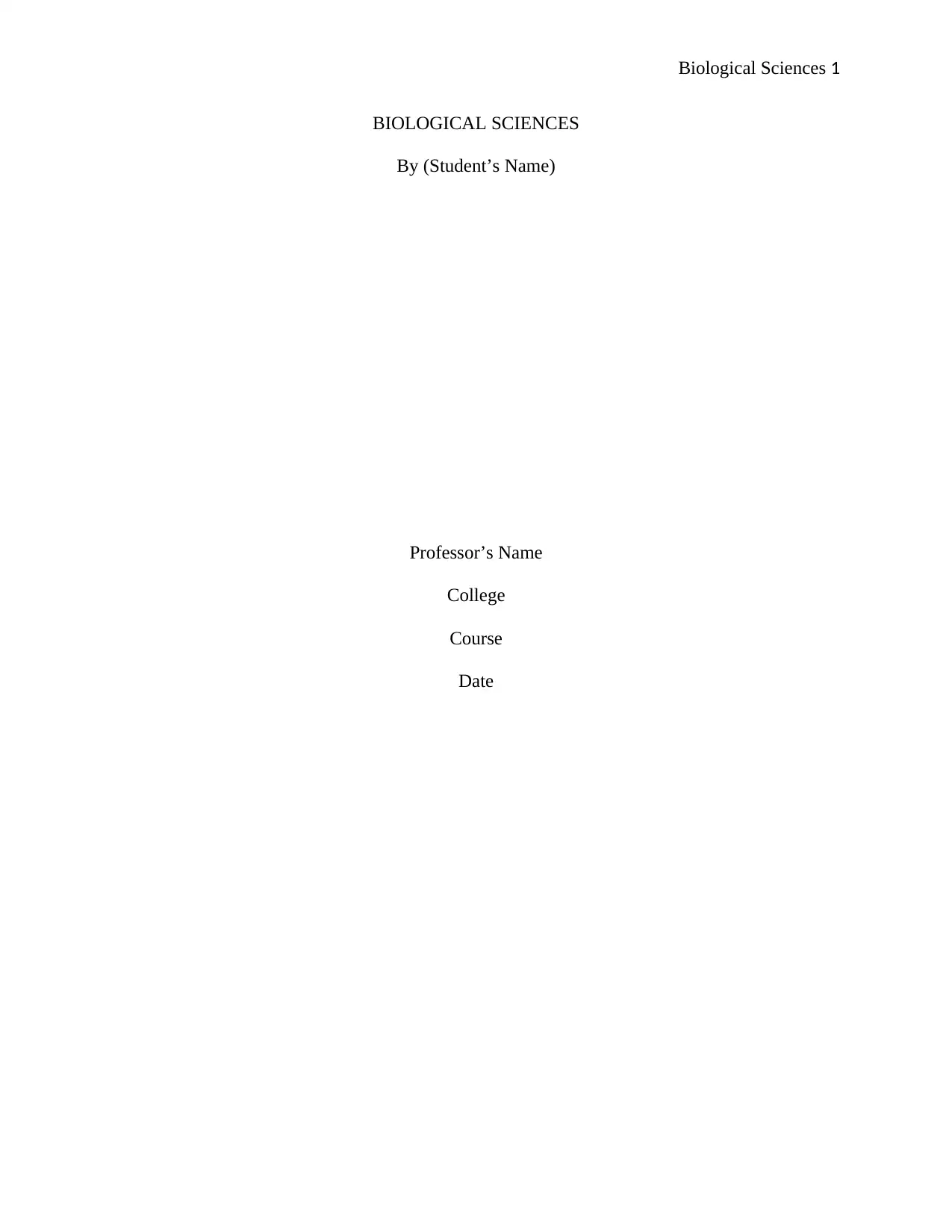
Biological Sciences 1
BIOLOGICAL SCIENCES
By (Student’s Name)
Professor’s Name
College
Course
Date
BIOLOGICAL SCIENCES
By (Student’s Name)
Professor’s Name
College
Course
Date
Paraphrase This Document
Need a fresh take? Get an instant paraphrase of this document with our AI Paraphraser
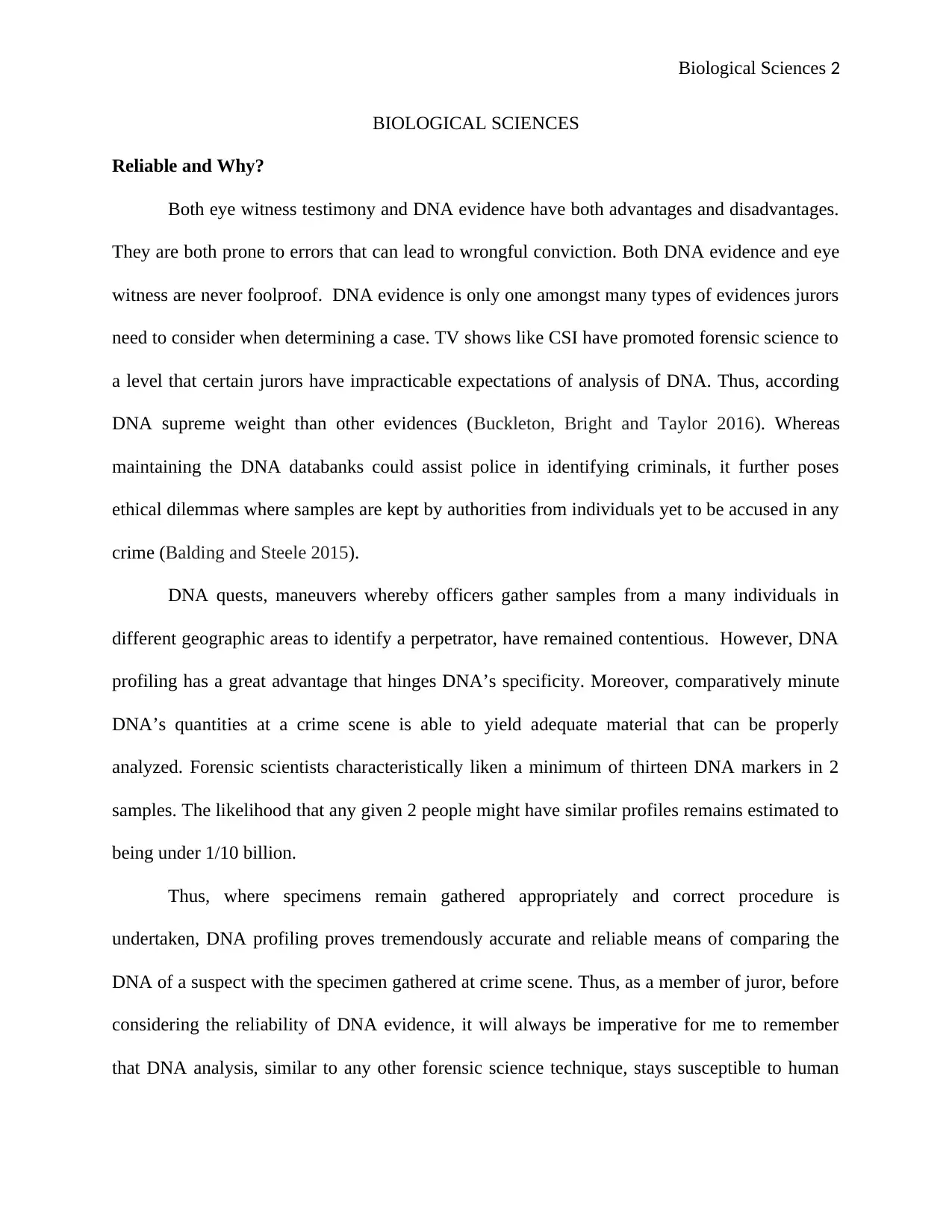
Biological Sciences 2
BIOLOGICAL SCIENCES
Reliable and Why?
Both eye witness testimony and DNA evidence have both advantages and disadvantages.
They are both prone to errors that can lead to wrongful conviction. Both DNA evidence and eye
witness are never foolproof. DNA evidence is only one amongst many types of evidences jurors
need to consider when determining a case. TV shows like CSI have promoted forensic science to
a level that certain jurors have impracticable expectations of analysis of DNA. Thus, according
DNA supreme weight than other evidences (Buckleton, Bright and Taylor 2016). Whereas
maintaining the DNA databanks could assist police in identifying criminals, it further poses
ethical dilemmas where samples are kept by authorities from individuals yet to be accused in any
crime (Balding and Steele 2015).
DNA quests, maneuvers whereby officers gather samples from a many individuals in
different geographic areas to identify a perpetrator, have remained contentious. However, DNA
profiling has a great advantage that hinges DNA’s specificity. Moreover, comparatively minute
DNA’s quantities at a crime scene is able to yield adequate material that can be properly
analyzed. Forensic scientists characteristically liken a minimum of thirteen DNA markers in 2
samples. The likelihood that any given 2 people might have similar profiles remains estimated to
being under 1/10 billion.
Thus, where specimens remain gathered appropriately and correct procedure is
undertaken, DNA profiling proves tremendously accurate and reliable means of comparing the
DNA of a suspect with the specimen gathered at crime scene. Thus, as a member of juror, before
considering the reliability of DNA evidence, it will always be imperative for me to remember
that DNA analysis, similar to any other forensic science technique, stays susceptible to human
BIOLOGICAL SCIENCES
Reliable and Why?
Both eye witness testimony and DNA evidence have both advantages and disadvantages.
They are both prone to errors that can lead to wrongful conviction. Both DNA evidence and eye
witness are never foolproof. DNA evidence is only one amongst many types of evidences jurors
need to consider when determining a case. TV shows like CSI have promoted forensic science to
a level that certain jurors have impracticable expectations of analysis of DNA. Thus, according
DNA supreme weight than other evidences (Buckleton, Bright and Taylor 2016). Whereas
maintaining the DNA databanks could assist police in identifying criminals, it further poses
ethical dilemmas where samples are kept by authorities from individuals yet to be accused in any
crime (Balding and Steele 2015).
DNA quests, maneuvers whereby officers gather samples from a many individuals in
different geographic areas to identify a perpetrator, have remained contentious. However, DNA
profiling has a great advantage that hinges DNA’s specificity. Moreover, comparatively minute
DNA’s quantities at a crime scene is able to yield adequate material that can be properly
analyzed. Forensic scientists characteristically liken a minimum of thirteen DNA markers in 2
samples. The likelihood that any given 2 people might have similar profiles remains estimated to
being under 1/10 billion.
Thus, where specimens remain gathered appropriately and correct procedure is
undertaken, DNA profiling proves tremendously accurate and reliable means of comparing the
DNA of a suspect with the specimen gathered at crime scene. Thus, as a member of juror, before
considering the reliability of DNA evidence, it will always be imperative for me to remember
that DNA analysis, similar to any other forensic science technique, stays susceptible to human
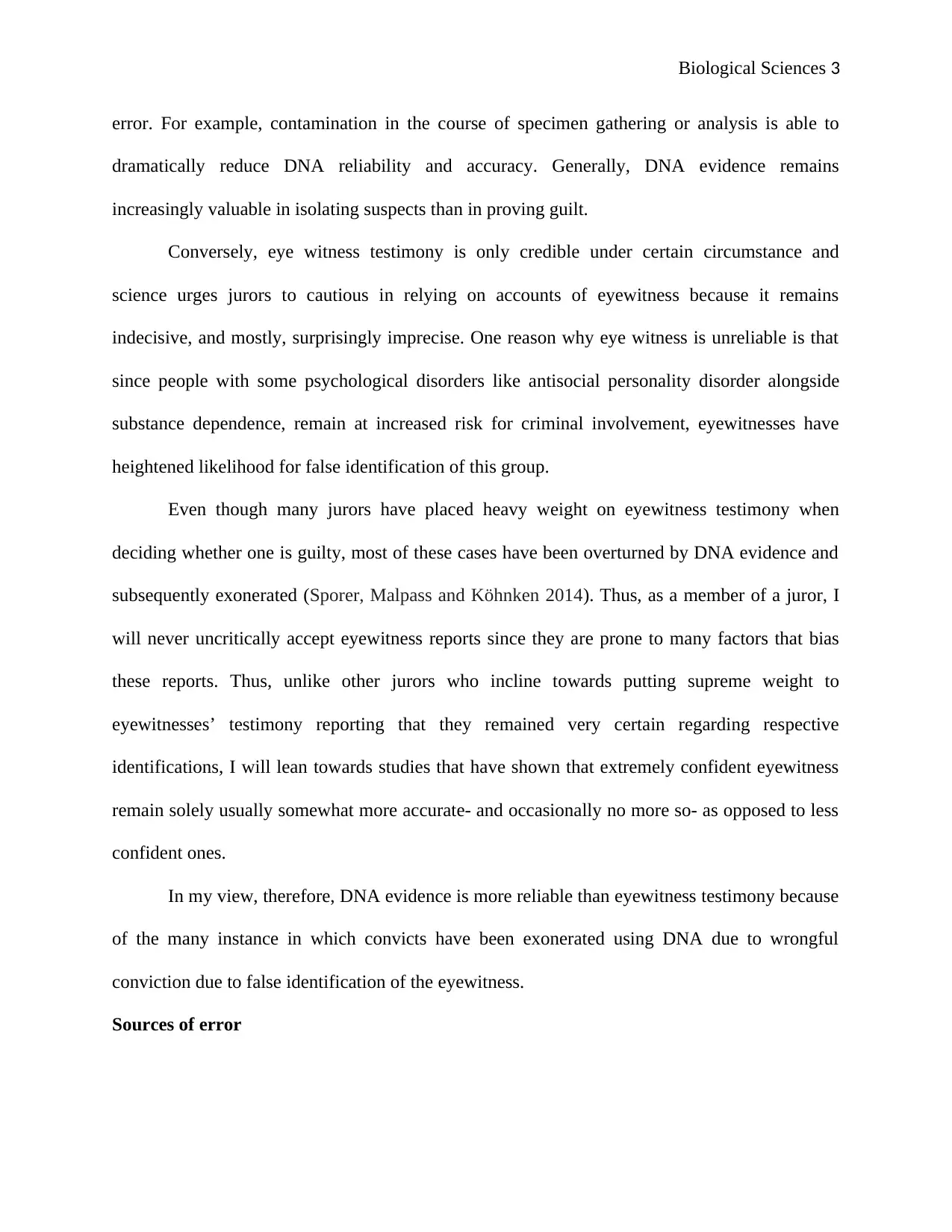
Biological Sciences 3
error. For example, contamination in the course of specimen gathering or analysis is able to
dramatically reduce DNA reliability and accuracy. Generally, DNA evidence remains
increasingly valuable in isolating suspects than in proving guilt.
Conversely, eye witness testimony is only credible under certain circumstance and
science urges jurors to cautious in relying on accounts of eyewitness because it remains
indecisive, and mostly, surprisingly imprecise. One reason why eye witness is unreliable is that
since people with some psychological disorders like antisocial personality disorder alongside
substance dependence, remain at increased risk for criminal involvement, eyewitnesses have
heightened likelihood for false identification of this group.
Even though many jurors have placed heavy weight on eyewitness testimony when
deciding whether one is guilty, most of these cases have been overturned by DNA evidence and
subsequently exonerated (Sporer, Malpass and Köhnken 2014). Thus, as a member of a juror, I
will never uncritically accept eyewitness reports since they are prone to many factors that bias
these reports. Thus, unlike other jurors who incline towards putting supreme weight to
eyewitnesses’ testimony reporting that they remained very certain regarding respective
identifications, I will lean towards studies that have shown that extremely confident eyewitness
remain solely usually somewhat more accurate- and occasionally no more so- as opposed to less
confident ones.
In my view, therefore, DNA evidence is more reliable than eyewitness testimony because
of the many instance in which convicts have been exonerated using DNA due to wrongful
conviction due to false identification of the eyewitness.
Sources of error
error. For example, contamination in the course of specimen gathering or analysis is able to
dramatically reduce DNA reliability and accuracy. Generally, DNA evidence remains
increasingly valuable in isolating suspects than in proving guilt.
Conversely, eye witness testimony is only credible under certain circumstance and
science urges jurors to cautious in relying on accounts of eyewitness because it remains
indecisive, and mostly, surprisingly imprecise. One reason why eye witness is unreliable is that
since people with some psychological disorders like antisocial personality disorder alongside
substance dependence, remain at increased risk for criminal involvement, eyewitnesses have
heightened likelihood for false identification of this group.
Even though many jurors have placed heavy weight on eyewitness testimony when
deciding whether one is guilty, most of these cases have been overturned by DNA evidence and
subsequently exonerated (Sporer, Malpass and Köhnken 2014). Thus, as a member of a juror, I
will never uncritically accept eyewitness reports since they are prone to many factors that bias
these reports. Thus, unlike other jurors who incline towards putting supreme weight to
eyewitnesses’ testimony reporting that they remained very certain regarding respective
identifications, I will lean towards studies that have shown that extremely confident eyewitness
remain solely usually somewhat more accurate- and occasionally no more so- as opposed to less
confident ones.
In my view, therefore, DNA evidence is more reliable than eyewitness testimony because
of the many instance in which convicts have been exonerated using DNA due to wrongful
conviction due to false identification of the eyewitness.
Sources of error
⊘ This is a preview!⊘
Do you want full access?
Subscribe today to unlock all pages.

Trusted by 1+ million students worldwide
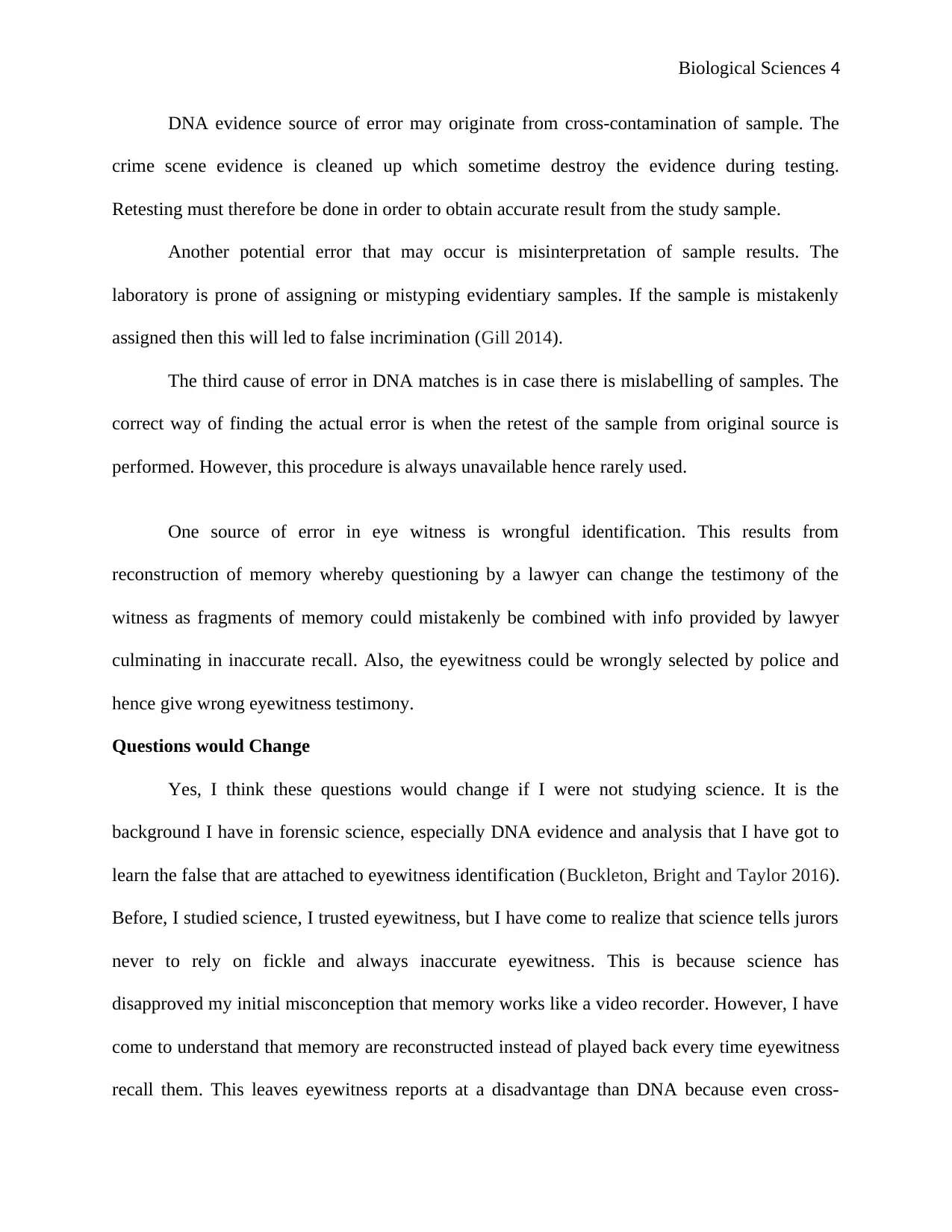
Biological Sciences 4
DNA evidence source of error may originate from cross-contamination of sample. The
crime scene evidence is cleaned up which sometime destroy the evidence during testing.
Retesting must therefore be done in order to obtain accurate result from the study sample.
Another potential error that may occur is misinterpretation of sample results. The
laboratory is prone of assigning or mistyping evidentiary samples. If the sample is mistakenly
assigned then this will led to false incrimination (Gill 2014).
The third cause of error in DNA matches is in case there is mislabelling of samples. The
correct way of finding the actual error is when the retest of the sample from original source is
performed. However, this procedure is always unavailable hence rarely used.
One source of error in eye witness is wrongful identification. This results from
reconstruction of memory whereby questioning by a lawyer can change the testimony of the
witness as fragments of memory could mistakenly be combined with info provided by lawyer
culminating in inaccurate recall. Also, the eyewitness could be wrongly selected by police and
hence give wrong eyewitness testimony.
Questions would Change
Yes, I think these questions would change if I were not studying science. It is the
background I have in forensic science, especially DNA evidence and analysis that I have got to
learn the false that are attached to eyewitness identification (Buckleton, Bright and Taylor 2016).
Before, I studied science, I trusted eyewitness, but I have come to realize that science tells jurors
never to rely on fickle and always inaccurate eyewitness. This is because science has
disapproved my initial misconception that memory works like a video recorder. However, I have
come to understand that memory are reconstructed instead of played back every time eyewitness
recall them. This leaves eyewitness reports at a disadvantage than DNA because even cross-
DNA evidence source of error may originate from cross-contamination of sample. The
crime scene evidence is cleaned up which sometime destroy the evidence during testing.
Retesting must therefore be done in order to obtain accurate result from the study sample.
Another potential error that may occur is misinterpretation of sample results. The
laboratory is prone of assigning or mistyping evidentiary samples. If the sample is mistakenly
assigned then this will led to false incrimination (Gill 2014).
The third cause of error in DNA matches is in case there is mislabelling of samples. The
correct way of finding the actual error is when the retest of the sample from original source is
performed. However, this procedure is always unavailable hence rarely used.
One source of error in eye witness is wrongful identification. This results from
reconstruction of memory whereby questioning by a lawyer can change the testimony of the
witness as fragments of memory could mistakenly be combined with info provided by lawyer
culminating in inaccurate recall. Also, the eyewitness could be wrongly selected by police and
hence give wrong eyewitness testimony.
Questions would Change
Yes, I think these questions would change if I were not studying science. It is the
background I have in forensic science, especially DNA evidence and analysis that I have got to
learn the false that are attached to eyewitness identification (Buckleton, Bright and Taylor 2016).
Before, I studied science, I trusted eyewitness, but I have come to realize that science tells jurors
never to rely on fickle and always inaccurate eyewitness. This is because science has
disapproved my initial misconception that memory works like a video recorder. However, I have
come to understand that memory are reconstructed instead of played back every time eyewitness
recall them. This leaves eyewitness reports at a disadvantage than DNA because even cross-
Paraphrase This Document
Need a fresh take? Get an instant paraphrase of this document with our AI Paraphraser
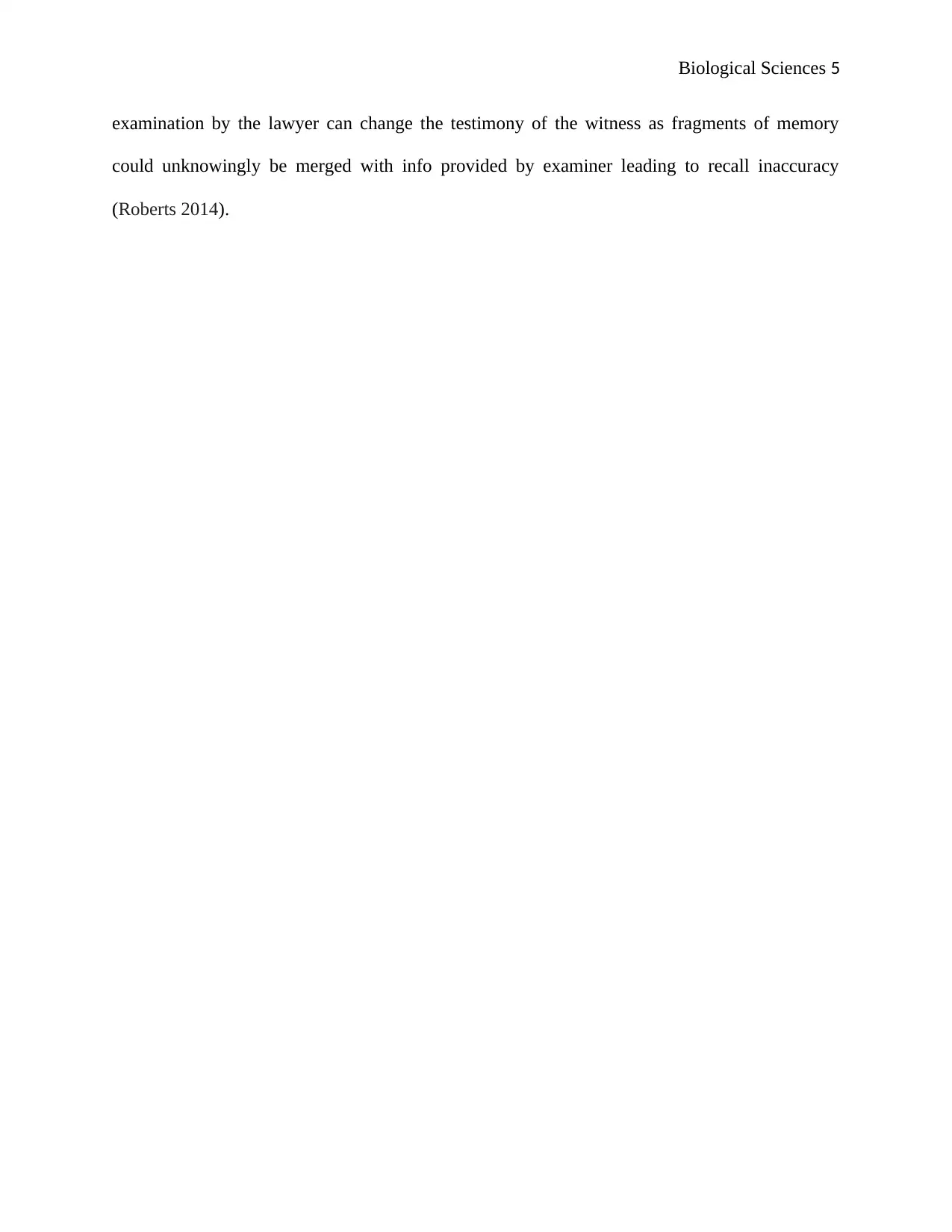
Biological Sciences 5
examination by the lawyer can change the testimony of the witness as fragments of memory
could unknowingly be merged with info provided by examiner leading to recall inaccuracy
(Roberts 2014).
examination by the lawyer can change the testimony of the witness as fragments of memory
could unknowingly be merged with info provided by examiner leading to recall inaccuracy
(Roberts 2014).
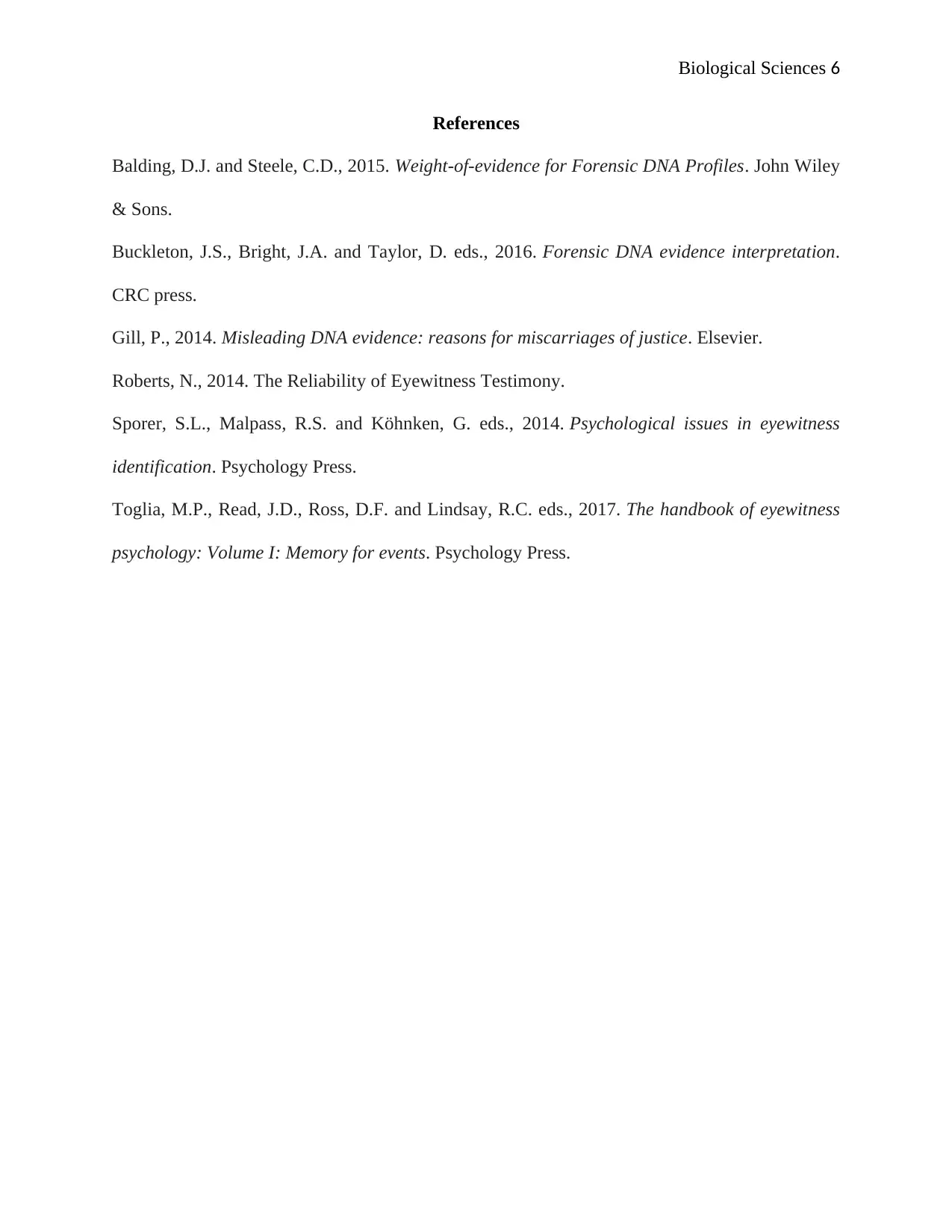
Biological Sciences 6
References
Balding, D.J. and Steele, C.D., 2015. Weight-of-evidence for Forensic DNA Profiles. John Wiley
& Sons.
Buckleton, J.S., Bright, J.A. and Taylor, D. eds., 2016. Forensic DNA evidence interpretation.
CRC press.
Gill, P., 2014. Misleading DNA evidence: reasons for miscarriages of justice. Elsevier.
Roberts, N., 2014. The Reliability of Eyewitness Testimony.
Sporer, S.L., Malpass, R.S. and Köhnken, G. eds., 2014. Psychological issues in eyewitness
identification. Psychology Press.
Toglia, M.P., Read, J.D., Ross, D.F. and Lindsay, R.C. eds., 2017. The handbook of eyewitness
psychology: Volume I: Memory for events. Psychology Press.
References
Balding, D.J. and Steele, C.D., 2015. Weight-of-evidence for Forensic DNA Profiles. John Wiley
& Sons.
Buckleton, J.S., Bright, J.A. and Taylor, D. eds., 2016. Forensic DNA evidence interpretation.
CRC press.
Gill, P., 2014. Misleading DNA evidence: reasons for miscarriages of justice. Elsevier.
Roberts, N., 2014. The Reliability of Eyewitness Testimony.
Sporer, S.L., Malpass, R.S. and Köhnken, G. eds., 2014. Psychological issues in eyewitness
identification. Psychology Press.
Toglia, M.P., Read, J.D., Ross, D.F. and Lindsay, R.C. eds., 2017. The handbook of eyewitness
psychology: Volume I: Memory for events. Psychology Press.
⊘ This is a preview!⊘
Do you want full access?
Subscribe today to unlock all pages.

Trusted by 1+ million students worldwide
1 out of 6
Your All-in-One AI-Powered Toolkit for Academic Success.
+13062052269
info@desklib.com
Available 24*7 on WhatsApp / Email
![[object Object]](/_next/static/media/star-bottom.7253800d.svg)
Unlock your academic potential
Copyright © 2020–2025 A2Z Services. All Rights Reserved. Developed and managed by ZUCOL.